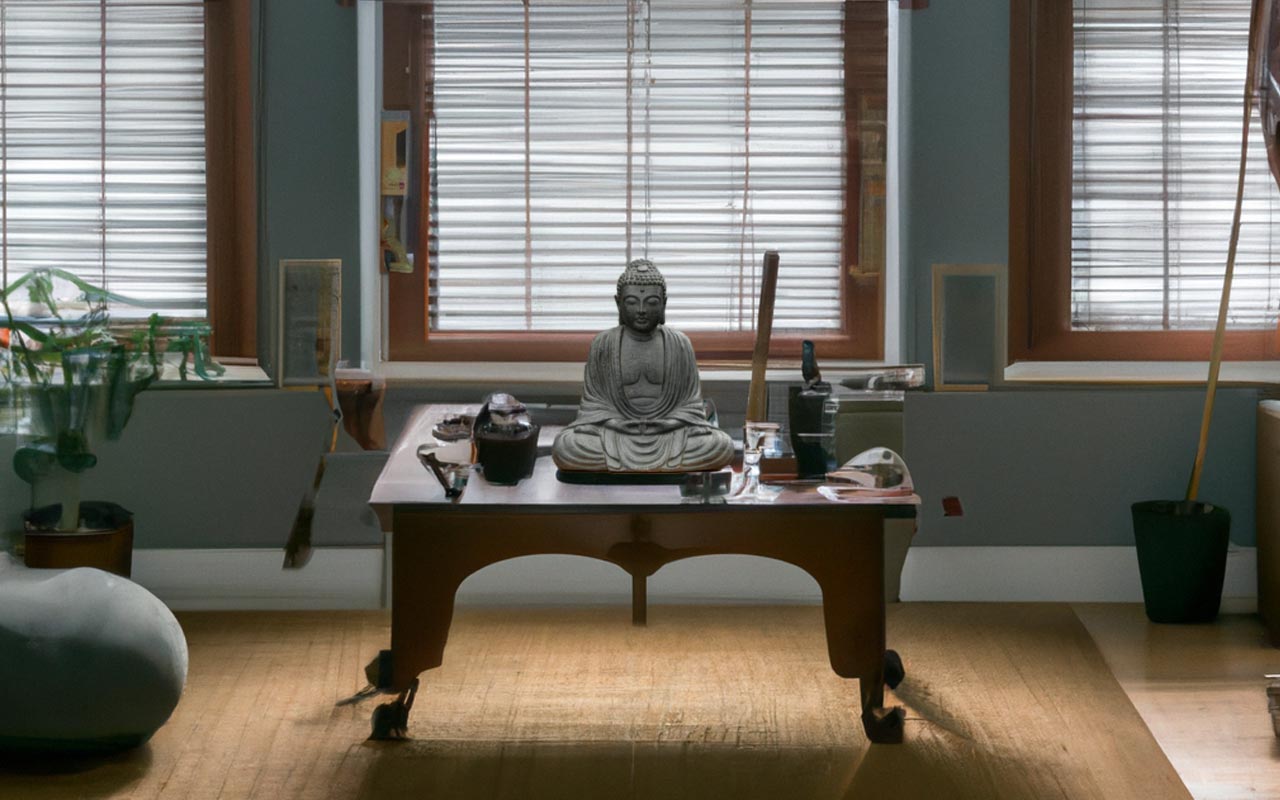How To Create a Zen Dojo At Home?
The dojo, or meditation hall, is an essential component of Zen meditation practice.
Suppose you’re anything like me and prioritize your daily Zen meditation practice. In that case, creating your own personal Zen space or dojo in your home is beneficial to fully immerse yourself in your meditation practice.
Having a Zen dojo at home provides a dedicated space for practitioners to meditate and deepen their understanding of Zen teachings.
In this article, I will give you tips on creating a Zen dojo in the comfort of your own home so that you can establish a regular meditation practice and experience the benefits of Zen in your daily life.
What is a Home Zen Dojo?
A Zen Dojo is a space dedicated to Zen practice and meditation. It is a place where practitioners can cultivate mindfulness, awareness, and inner peace. In traditional Zen practice, a Dojo is a place where monks come together to meditate, study, and practice the teachings of the Buddha. However, a home Zen Dojo can be created for personal practice and reflection.
Having a home Zen Dojo can be valuable for anyone looking to deepen their meditation practice and cultivate mindfulness daily. By creating a dedicated space for Zazen meditation, practitioners can create a sense of routine and consistency in their practice, leading to a greater sense of inner peace and well-being.
What Are The Benefits Of Having a Zen Dojo at Home?
Creating a Zen Dojo or meditation space at home can be a powerful tool for cultivating mindfulness, awareness, and inner peace. It provides practitioners with a dedicated space to practice Zen meditation and study the teachings of the Buddha without the distractions and stresses of daily life.
Here are some benefits of creating a Zen Dojo at home:
- Provides a dedicated space for meditation practice, promoting focus and discipline.
- Creates a peaceful and calming atmosphere that can help to reduce stress and anxiety.
- Eliminates the need to travel to a meditation center or temple, making practice more accessible and convenient.
- Fosters a sense of community and connection, as practitioners can invite others to practice with them in their home Zen Dojo.
- Creates a sense of routine and consistency in practice, leading to a greater sense of inner peace and well-being.
- Allows for personalization and customization of the practice space to suit individual needs and preferences.
- It can serve as a reminder to prioritize self-care and mindfulness daily.
From my experience, having a dedicated space at home for meditation will be a powerful tool for anyone looking to deepen their meditation practice and experience mindfulness’s many benefits.
What Are The Characteristics of a Good Home Zen Dojo?
A Zen Dojo is a space where Zen practitioners cultivate inner peace and focus through meditation and mindfulness. Whether you are an experienced practitioner or just starting your Zen journey, having a dedicated space in your home for Zazen practice can be a valuable asset.
A good home Zen Dojo should be designed with intention and care to create an environment that supports your practice, helps you cultivate a calm and peaceful mind, and fosters a deeper connection to your inner self. It also helps your Zazen practice remain consistent, effective, and fulfilling.
A good home Zen Dojo should have the following characteristics:
- Serene Atmosphere: The atmosphere should be calm, peaceful, and free from distractions. The space should be quiet, and the colors and decor should be soothing and conducive to meditation.
- Proper Lighting: Lighting should be soft, natural, and not too bright. It should be possible to dim the lights when necessary.
- Right Temperature: The temperature should be comfortable and conducive to meditation. The ideal temperature for a Zen Dojo is around 68-72°F (20-22°C). It’s best to avoid extremes in temperature, whether too hot or too cold, as this can be distracting and uncomfortable for practitioners.
- Cleanliness: The Dojo should be kept clean and tidy. This will help create a peaceful and calming atmosphere.
- Natural Elements: Natural elements such as plants, stones, or water features can add to the atmosphere of the dojo and help connect practitioners to nature.
- Quiet Environment: The Dojo should be located in a quiet part of the home, away from noise and distractions. It should be soundproofed to reduce outside noise.
- Minimalism: The Dojo should be simple and uncluttered, with minimal decorations or distractions. This will help practitioners focus on their practice and avoid distraction.
- Accessibility: The Dojo should be easily accessible and available to use at any time of day. Practitioners should be able to use the dojo whenever they need to practice.
Overall, a good home Zen Dojo should provide a peaceful, comfortable, and inspiring environment for Zen practice.
What Items Do You Find In A Home Zen Dojo?
This section provides descriptions of the traditional Zen objects that can be used to create a Zen Dojo at home. Besides the Zafu and the Zabuton, these items are optional for practicing Zen meditation. Still, they help create a peaceful, calming, and pleasant atmosphere for the practice.
Zafu & Zabuton

Zafu and Zabuton are traditional meditation cushions that support the body in a comfortable and stable position during meditation. Zafu is a round cushion that lifts the hips and aligns the spine. At the same time, a zabuton is a rectangular cushion that provides a soft base for the knees and ankles.
Meditation Bench

A meditation bench is another option for sitting during meditation, especially for those with difficulty sitting cross-legged. The bench provides a stable and comfortable seat, allowing for longer and deeper meditation practice.
Samue Clothing

Samue is a traditional Japanese clothing worn during Zen practice. It consists of a loose-fitting top and pants made of cotton or linen. Wearing Samue can create a sense of focus and discipline during Zen practice.
Incense Bowl & Sticks

Burning incense is common in Zen meditation. The incense bowl holds the incense stick, while the smoke from the incense helps to purify the air and create a calming atmosphere.
Buddhist Statue

A Buddhist statue can be placed on the altar table as a reminder of the teachings of Zen practice. The statue can be of the Buddha or other Zen figures, and its presence can help to inspire and focus the mind during meditation.
Meditation Timer

A meditation timer helps practitioners track their meditation practice. It can be set to a specific amount of time and signal the end of the meditation period with a bell or chime.
Meditation Bell

A meditation bell is a traditional Zen instrument that signals the beginning and end of meditation practice. Its clear and resonant sound can help to focus the mind and bring a sense of mindfulness to the present moment.
Altar Table

An altar table is a small table to hold the Zen objects used during meditation, particularly a Buddha statue. It can be a simple or ornate design. It should be placed in a prominent location in the Zen Dojo to create a sense of reverence and respect for the practice.
Conclusion
Creating a Zen Dojo in the comfort of your own home can be a powerful tool for cultivating inner peace, mindfulness, and emotional well-being.
By following the tips outlined in this article, you can design a space conducive to Zen practice, allowing you to deepen your understanding of the teachings of the Buddha and experience the benefits of meditation.
Remember that having a dedicated space for meditation can serve as a reminder to prioritize self-care and mindfulness daily, helping you to maintain a consistent practice and ultimately leading to a greater sense of inner peace and well-being.

